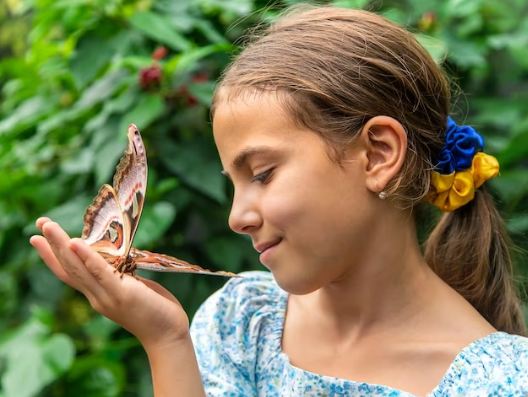Here are 50 fun facts about butterflies that kids might enjoy:

- Butterflies are insects, and they belong to the same group as moths.
- There are over 20,000 species of butterflies in the world.
- Butterflies come in many colors and patterns, and their wings can be quite intricate and beautiful.
- Some species of butterflies migrate long distances each year.
- Butterflies are cold-blooded and rely on the warmth of the sun to regulate their body temperature.
- Butterflies taste with their feet!
- Most butterflies have a lifespan of just a few weeks or months.
- The largest butterfly in the world is the Queen Alexandra’s birdwing, which has a wingspan of up to 1 foot!
- The smallest butterfly in the world is the Western Pygmy Blue, which is smaller than a dime.
- A group of butterflies is called a flutter.
- Butterflies can fly up to 30 miles per hour!
- Butterflies can see ultraviolet light, which humans cannot see.
- The chrysalis, or pupa, stage of a butterfly’s life cycle can last anywhere from a few days to a few months.
- Some species of butterflies are endangered, and conservation efforts are underway to protect them.
- Butterflies can taste food from flowers using their proboscis, which is like a long, flexible straw.
- Butterflies are important pollinators, helping plants to reproduce by carrying pollen from one flower to another.
- Some butterflies, like the Monarch, are poisonous to predators.
- Butterflies have been around for millions of years, and have evolved to survive in many different environments.
- Butterflies can lay hundreds of eggs at a time.
- Butterflies are closely related to the silk moth, which is used to produce silk fabric.
- Butterflies are found on every continent except for Antarctica.
- Some butterflies, like the Blue Morpho, have iridescent wings that appear to change color in different lights.
- Butterflies do not have lungs; they breathe through tiny tubes called tracheae.
- Butterflies have taste sensors on their legs and antennae.
- The lifecycle of a butterfly includes four stages: egg, caterpillar, pupa, and adult.
- Butterflies can fly at different altitudes, from just a few feet off the ground to over 10,000 feet in the air.
- Some species of butterflies are active at night, while others are active during the day.
- Butterflies are a popular subject for art and decoration, and can be found on everything from clothing to home decor.
- Some butterflies, like the Zebra Longwing, live in colonies.
- Butterflies do not have ears, but they can sense vibrations and changes in air pressure.
- Some species of butterflies are known to mimic the appearance of other, more poisonous butterflies as a defense mechanism.
- The wings of a butterfly are covered in tiny scales, which give them their colors and patterns.
- Some butterflies, like the Viceroy, mimic the appearance of other, more poisonous insects, like wasps.
- The lifespan of a butterfly varies depending on the species, with some living just a few days and others living up to a year.
- Butterflies can lay their eggs on a variety of plants, depending on the species.
- Some butterflies, like the Painted Lady, are able to hibernate during the winter months.
- The colors and patterns on a butterfly’s wings can help to attract mates or ward off predators.
- Butterflies can fly in a variety of patterns, including zigzags, spirals, and
- Butterflies can fly backwards, but they cannot fly upside down.
- Some butterflies, like the Red Admiral, are known for their erratic flight patterns.
- A butterfly’s proboscis can be longer than its body, allowing it to reach deep into flowers for nectar.
- The life cycle of a butterfly can vary depending on the temperature and climate of its environment.
- Butterflies can sense the presence of predators through their sense of smell.
- Some species of butterflies, like the Blue Morpho, have wings that are highly reflective and can be seen from a distance.
- Butterflies have excellent vision and can see many different colors.
- Some species of butterflies are known to travel in groups, or swarms, during migration.
- Butterflies are often used as symbols of transformation, renewal, and freedom.
- The process of a caterpillar transforming into a butterfly is called metamorphosis.
- Butterflies are important indicators of environmental health and can be used to monitor the health of ecosystems.
- Butterflies are a popular subject for scientific study, and researchers are continually learning more about their behavior, biology, and ecology.





















